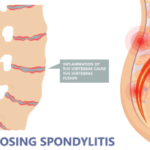There are several potential driving mechanisms to explain altered bone remodeling in SpA, Dr. Ritchlin said. Two possibilities are a cytokine environment and enthesitis.
Several cytokines and cytokine pathways are of interest in SpA, psoriasis and PsA, Dr. Ritchlin said. These include TNF and interleukin (IL) 23/IL-17. According to one murine model, TNF plays a key role in SpA because blocking this cytokine significantly reduces inflammation and destruction.1 “In addition, a murine model that overproduces membrane-bound TNF develops a spondyloarthritis phenotype, in contrast to models with overproduction of membrane TNF, which look more like [rheumatoid arthritis],” Dr. Ritchlin said.
The researchers also noted that the IL-23/IL-17 axis is “emerging as an important inflammatory pathway in SpA.” Reasons for this include that a SNP in the IL-23R locus has been associated with developing AS, overexpression of IL-23 in mice leads to the development of SpA-like features, and blocking IL-17 has demonstrated therapeutic value in AS patients.
Enthesitis is a hallmark of peripheral SpA, most typically of the Achilles tendon and plantar fascia. The cytokine IL-23 and resident T cells promote enthesitis and osteoproliferation in a recent murine model by Sherlock et al, Dr. Ritchlin said.2
Biomechanical strain has been proposed to be a driving factor in osteoproliferation. “Formal proof” for this concept was provided by Jacques et al, who showed that arthritis did not develop in the rear joints in a murine SpA model when the hind limbs were unloaded by suspending the mouse by the tail.3
New data have unveiled potential novel targets, & older drugs, such as NSAIDs, can decrease pathologic new bone formation.
Diagnosis
A recent consensus statement based on a systematic literature review by the Assessment of SpondyloArthritis International Society (ASAS) suggested the presence of three or more corner inflammatory lesions or of several corner fat lesions as candidate definitions for a positive MRI of the spine in axial SpA. However, “caution is warranted if classification of SpA is based solely on spinal MRI,” Dr. Ritchlin said. He explained that a positive spinal MRI shows low diagnostic utility in nonradiographic axial spondyloarthritis (nr-axSpA).
Clinical classification of axial SpA is further complicated by a recent analysis of a North American SpA cohort, which shows there are key differences between subsets of axial SpA, and gender plays a role in inflammation and radiographic severity. “Thus, female SpA patients are more likely to present with normal acute phase reactants and normal sacroiliac radiographs negative compared to their male counterparts,” Dr. Ritchlin said.
Therapeutic Options
Therapeutic options for AS with predominant axial manifestations have been limited to NSAIDs and, if this option fails, to TNF-α blockers. Research is refining the rationale for using these drugs and shows promise for additional options. In AS, Dr. Ritchlin pointed out three potential strategies to block pathologic bone formation, the first two of which can be used by rheumatologists now:
- Early diagnosis and treatment with antiinflammatory agents rapidly controls inflammation and prevents the molecular switch to new bone apposition.
- The combination of anti-TNF agents with NSAIDs blocks the effects of PGE2 on osteoproliferation, according to recent clinical studies.
- Use of BMP antagonists or Wnt inhibitors (DKK-1 or sclerostin) blocks pathologic new bone formation.
TNFi therapy has shown promise in patients with inflammatory back pain, suggestive of ax-SpA. Of note, Dr. Ritchlin said, patients with imaging abnormalities (e.g., X-ray sacroiliitis, MRI sacroiliitis) are more likely to respond to TNFi treatment than patients who do not have these imaging findings.

